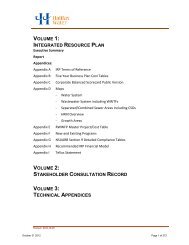Guidelines for the Preparation of Transportation Impact Studies - 8th ...
Guidelines for the Preparation of Transportation Impact Studies - 8th ...
Guidelines for the Preparation of Transportation Impact Studies - 8th ...
You also want an ePaper? Increase the reach of your titles
YUMPU automatically turns print PDFs into web optimized ePapers that Google loves.
4.0 Establishing a <strong>Transportation</strong> Context <strong>for</strong> <strong>the</strong> Analysis<br />
The elements useful in developing a suitable transportation context <strong>for</strong> <strong>the</strong> TIS are outlined in<br />
this section. The projected transportation impacts <strong>of</strong> <strong>the</strong> proposed development or<br />
redevelopment will later be compared with this summary <strong>of</strong> baseline conditions.<br />
The objective here is to create a picture <strong>of</strong> transportation conditions be<strong>for</strong>e <strong>the</strong><br />
development or redevelopment is completed and occupied to compare with expected<br />
conditions after occupation.<br />
4.1 Horizon Year and Time Periods <strong>for</strong> Analysis<br />
4.1.1 Identify <strong>the</strong> horizon year <strong>for</strong> <strong>the</strong> impact analysis. In general this will be five years from <strong>the</strong><br />
date <strong>of</strong> <strong>the</strong> TIS unless an earlier date <strong>for</strong> occupancy <strong>of</strong> <strong>the</strong> development can be supported.<br />
Where development is to be phased, or where future major transportation changes will<br />
affect travel to/from <strong>the</strong> development, analysis <strong>of</strong> scenarios <strong>for</strong> additional horizon year(s)<br />
may be appropriate.<br />
4.1.2 Consider both <strong>the</strong> morning and afternoon peak hours, <strong>the</strong>se being established on <strong>the</strong> basis<br />
<strong>of</strong> <strong>the</strong> worst-case combination <strong>of</strong> site-generated trips and non-site-related travel. In some<br />
cases, such as Saturday afternoons <strong>for</strong> retail developments, o<strong>the</strong>r peak hours should be<br />
analyzed if <strong>the</strong>y represent a worst-case situation with respect to ei<strong>the</strong>r site-generated or<br />
non-site-related travel.<br />
Consultation with Halifax Regional Municipality staff may be useful in determining<br />
<strong>the</strong> appropriate horizon year and time periods <strong>for</strong> analysis.<br />
4.2 Existing Traffic Conditions<br />
4.2.1 Show on a map or maps existing traffic volumes <strong>for</strong> streets and intersections in <strong>the</strong> study<br />
area, including <strong>the</strong> proportion <strong>of</strong> large trucks and buses <strong>for</strong> consideration in <strong>the</strong> street and<br />
intersection per<strong>for</strong>mance analysis.<br />
The most recent traffic counts available should generally be used. It may also be possible<br />
to use count or <strong>for</strong>ecast data from o<strong>the</strong>r recent TIS reports conducted <strong>for</strong> development<br />
proposals in <strong>the</strong> same area. Usually, traffic counts more than two years old should be<br />
updated. Where <strong>the</strong> available traffic count data is not representative <strong>of</strong> current conditions<br />
TISGUIDE8.WPD September 1, 2007 page 10
















